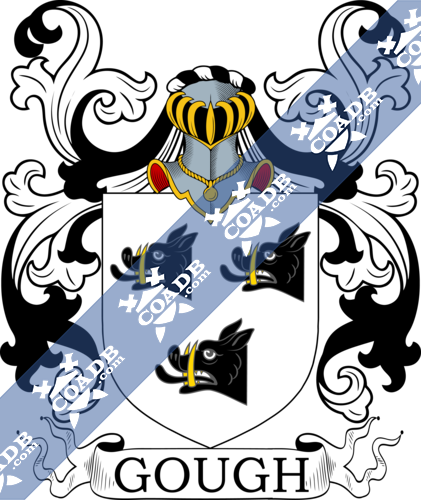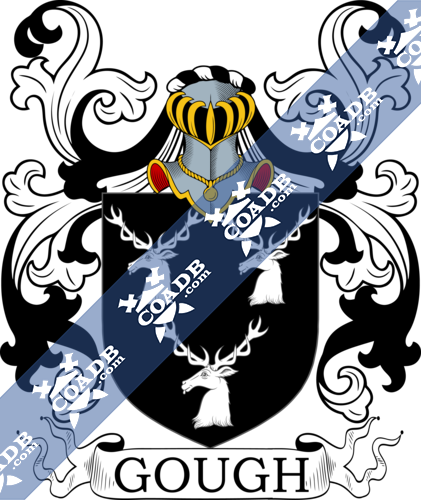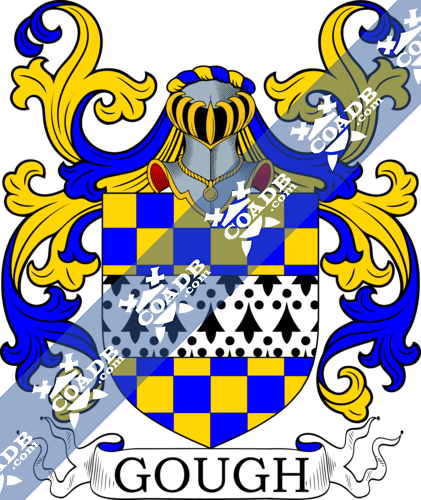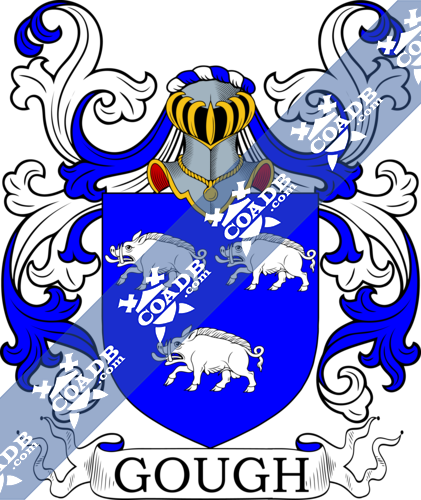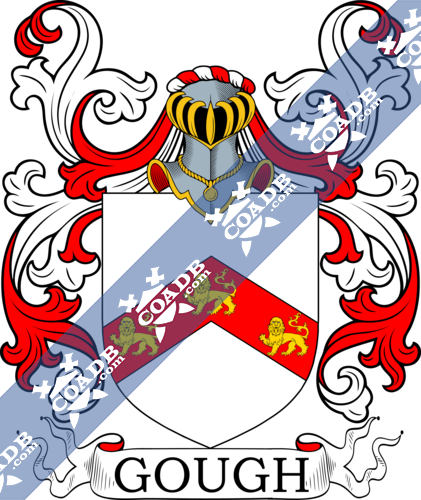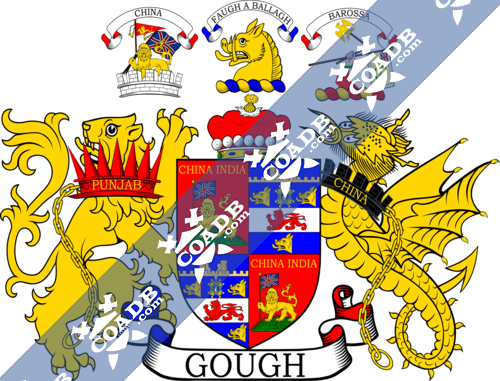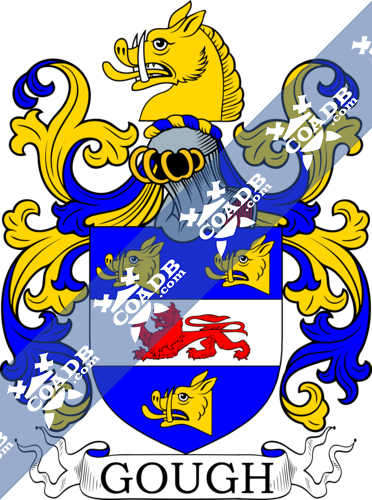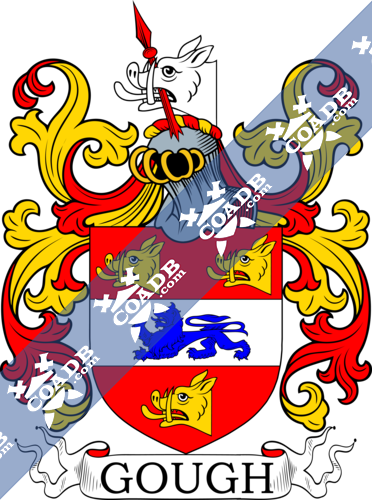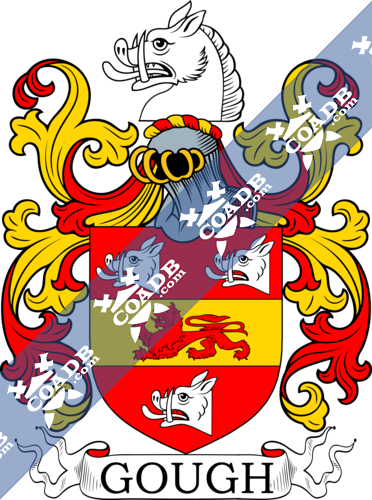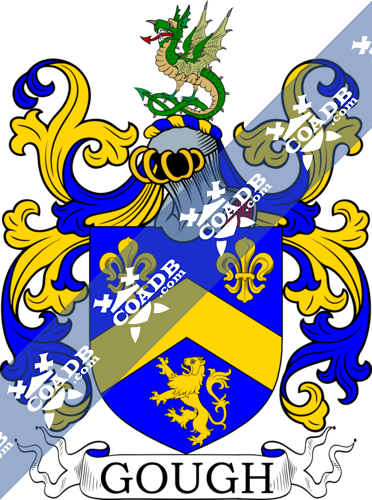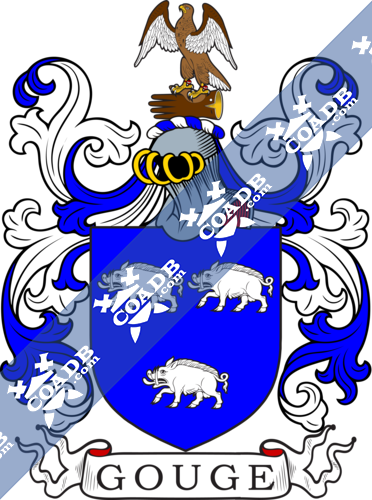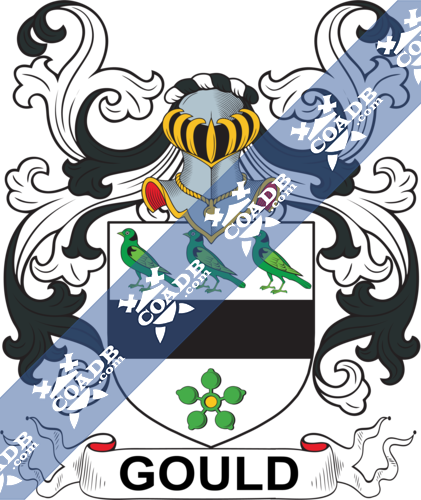Gough Family Crest, Coat of Arms and Name History
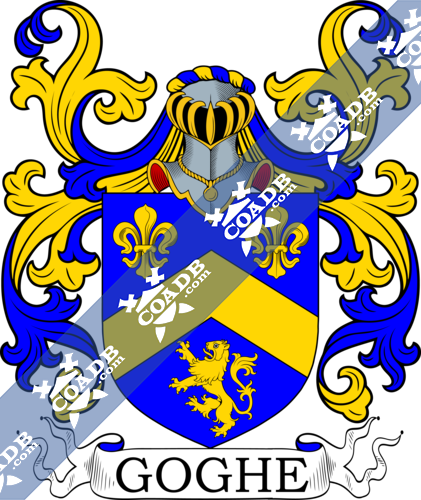
Gough Coat of Arms Gallery
Don’t know which Coat of Arms is yours?
We can do a genealogical research. Find out the exact history of your family!
Learn MoreGough Origin:
England
Origins of Gough:
Listed in many spellings including Gough, Goff, Goffe, Goth, Gouth, and unusual dialects such as Coath and Couth, this interesting surname is usually English when listed in England. It has two known origins. The first is professional from the Cornish word and Breton word “goff” meaning a Smith. This form may have been introduced into England by the supporters of William the Champion after the Invasion of 1066. Professional surnames originally only became hereditary when a son, or possibly a grandson, followed his father into the same line of business. The second possible origin is Welsh from the old word “coch” meaning red. As such it was probably given as an ethnic nickname to an Anglo-Saxon, as many of these people had red hair or a red complexion. Sometimes the initial “g” was exchanged with “c,” but this may put down to poor reading and writing, as well as strong languages. Early examples of records from church records of the city of London include the wedding of Elizabeth Gough and Rychard Walker in February 1549, at St. Michael’s Bassishaw and the christening of Elizabeth Coath, the daughter of Richard Coath, at Wandsworth, in December 1653.
Variations:
More common variations are: Goughe, Gougha, Gaugh, Cough, Gouph, Goufh, Gaughy, Gaughe, Coughi, Gaugha.
England:
The surname Gough first appeared in Radnorshire (Welsh: Sir Faesyfed), an old historic district of mid- Wales, anciently part of the kingdom of Powys, where they held a family seat from very early times. Some say well before the Norman Invasion and the arrival of Duke William at Hastings in 1066 AD.
The very first recording spelling of the family was shown to be that of Griffin Gogh, dated 1287, in the Assize Court of the county of Cheshire. It was during the reign of King Edward, who was known as “The Hammer of the Scots,” dated 1272-1307. Surname all over the country became a necessity with the introduction of personal taxation. It came to be known as Poll Tax in England. Surnames all over the country began to develop with unique and shocking spelling varieties of the original one.
Ireland:
Many of the people with surname Gough had moved to Ireland during the 17th century.
United States of America:
Individuals with the surname Gough landed in the United States in three different centuries respectively in the 17th, 18th, and 19th. Some of the people with the name Gough who arrived in the United States in the 17th century included Mathew Gough settled in Virginia in 1635. Mathew Gough, who landed in Virginia in 1639. People with the surname Gough who landed in the United States in the 18th century included William, Gough In, who arrived in Georgia in 1733. The following century saw much more Gough surnames arrive. Some of the people with the surname Gough who arrived in the United States in the 19th century included Miss Gough, who landed in New York, NY in 1817.
Canada:
People with the surname Gough who landed in the Canada in the 18th century included Martin Gough, who arrived in Nova Scotia in 1750. Mary Gough, who arrived in Nova Scotia in 1750. The following century saw much more Gough surnames arrive. Some of the people with the surname Gough who came in the Canada in the 19th century included Philip Gough, who arrived in Nova Scotia in 1833.
Australia:
Some of the individuals with the surname Gough who landed in Australia in the 19th century included Charles Gough, English convict from Bristol, who moved aboard the “Adamant” in March 1821, settling in New South Wales, Australia. Sophia Gough, English criminal from Worcester, who moved aboard the “Amphitrite” in August 1833, settling in New South Wales, Australia. Ann Gough, English convict from Lancaster, who was transported aboard the “Arab” in December 1835, settling in Van Diemen’s Land, Australia.
New-Zealand:
Some of the population with the surname Gough who arrived in New Zealand in the 19th century included Timothy Gough landed in Wellington, New Zealand in 1840. Marjory Gough at the age of 22, arrived in Wellington, New Zealand aboard the ship “London” in 1840. Timothy Gough at the age of 36, arrived in Wellington, New Zealand aboard the ship “London” in 1840.
Here is the population distribution of the last name Gough:
England 12,820; United States 10,474; Australia 4,610; Canada 2,718; South Africa 2,667; Wales 1,321; Ireland 1,310; Honduras 888; New Zealand 812; Scotland 696.
Notable People:
Ian Gough (b. 1976), was a Welsh rugby union football player.
Brigadier Guy Francis Gough (1893-1988), was a British Commanding Officer Advance Base 1st Army, North Africa.
Brigadier William George Hugh Gough (1897-1948), was a British Commanding Officer 50th Indian Parachute Brigade, India.
Blazons & Genealogy Notes
1) (Viscount Gough). Quarterly, 1st and 4th, gu. on a mount vert a lion pass. guard. or, supporting with the dexter paw the union flag ppr. and over the same, in chief, the words “ China, India,” in letters of gold; 2nd and 3rd, az. on a fesse ar. betw. three boars’ heads couped or, a lion pass. gu. (being his family arms), in the centre chief point, pendent from a riband ar. fimbriated az. a representation of the badge of the Spanish Order of Charles III. ppr. and on a chief a representation of the east wall of the fortress of Tarifa, with a breach betw. two turrets, and on the dexter turret the British flag flying also ppr. Crests—In the centre, on a wreath, a boar’s head couped at the neck or; on the dexter side, on a mural crown ar. a lion pass. guard. or, holding in the dexter paw two flag-staves in bend sinister ppr. the one bearing the union-flag of Great Britain and Ireland, surmounting the other, the staff thereof broken, with a triangular banner flowing therefrom, being intended to represent a Chinese flag, having thereon the device of a dragon, in an escroll, above the word “China;” on the sinister side, on a wreath, a dexter arm embowed, in the uniform of the 87th regiment, being gu. faced vert, the hand grasping the colour of the said regiment displ. and a representation of a French eagle reversed and depressed, the staff broken ppr. in an escroll above the word “Barrosa”. Supporters—On the dexter side a lion reguard. or, gorged with an eastern crown gu. with chain reflexed over the back gold, the rim of the crown inscribed “Punjab ” in letters also gold; on the sinister side a dragon (intended to represent the device upon a Chinese flag, granted to Viscount Gough in the crest of honourable augmentation) or, gorged with a mural crown sa. inscribed with the word “China,” and chained gold. Mottoes—Over the family crest, “Faugh a Ballagh;” over the first crest, “China;” and over the third, “Barrosa;” under the arms, “Goojerat.”
2) (Bristol, co. Gloucester, cos. Radnor and Somerset). Ar. three boars’ heads couped sa. armed or.
3) (Oldfallings and Perry Hall, co. Stafford). Motto—Domat omnia virtus. (exemplified, 1845, to the Hon. Frederick Gough-Calthorpe, on his taking the surname and arms of Gough only. The licence extended to his issue). Gu. on a fesse ar. betw. three boars’ beads couped or, a lion pass. az. Crest—A boar’s head couped ar. devouring a broken spear gu.
4) (Marshe, co. Salop). Sa. three nags’ heads erased ar.
5) (Meriatt, co. Somerset). Gu. on a fesse or, betw. three boars’ heads couped ar. a lion pass. of the field. Crest—A boar’s head couped at the neck ar.
6) (co. Warwick). Chequy or and az. a fesse erm.
7) (co. Lincoln, 1640, and Wales). Az. three boars pass. ar. two and one.
8) Ar. on a chev. gu. three lions pass. guard. or.
9) (Ireland; Garrett Gough, settled in Ireland, 1530, Reg. Ulster’s Office, by Carney, Ulster). (Kilmanahan, co. Waterford; allowed by Hawkins, Ulster, 1717). (Ballyorley, co. Wexford; Clement Gough, Esq., of Ballyorley, temp. William III., descended from the preceding, m. Mary, dau. of Rickard Donovan, of Clonmore, same co.). Az. a chev. betw. two fleurs-de-lis in chief and a lion ramp. in base or. Crest—A wyvern, tail nowed ppr.
10) (granted, 1816, to George Gough, Esq., of Woodstown, co. Limerick; descended from Right Rev. Francis Gough, Bishop of Limerick). Az. on a fess ar. betw. three boars’ heads couped or, a lion pass. gu. Crest—A boar’s head couped at the neck or, tusked ar. Motto—Gradu diverso via una.
11) (or Gough). (Sir James Goghe, knighted by Sir George Carey, Lord Deputy, 29 Sept. 1603). Az. a chev. betw. two fleurs-de-lis in chief and a lion ramp. in base or.
12) Az. a boar ar.


